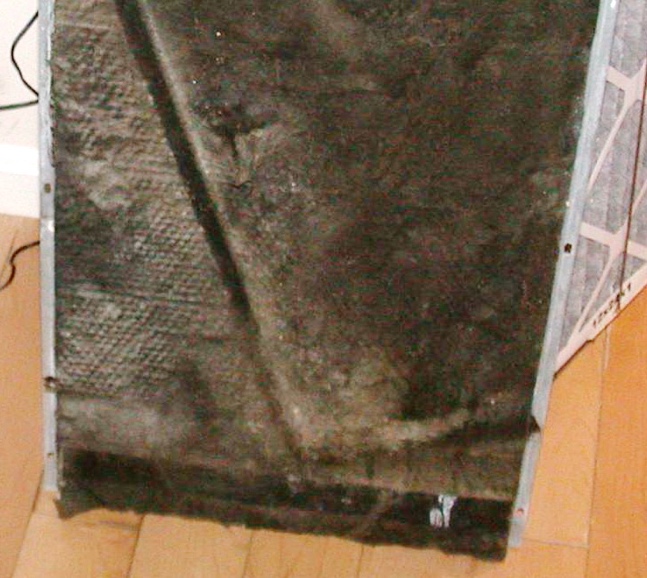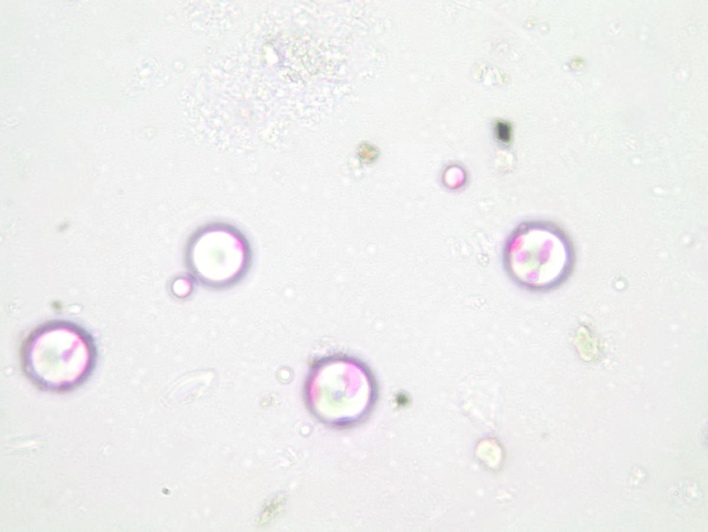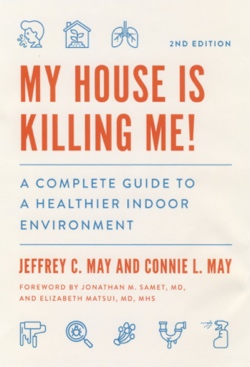IAQ IQ, Winter 2021-2022
©2022 Jeffrey C. May
I wrote this newsletter in 2010, after which it was published in “The ASHI Reporter.” In this updated version, I’ve added a few extra recommendations to acknowledge the threats we all face due to the pandemic, which remains a serious concern even if people are vaccinated.
I’ll start by discussing some conditions that can cause indoor air quality problems in general as well as pose exposure threats to you in particular. Most of you are home inspectors, and many of the buildings you enter contain contaminants or irritants that could cause you to sneeze, wheeze or cough.
- Air handlers can contain allergenic dust, whether collected purposely on the filter or, if the filter is inadequate, collected inadvertently on fibrous lining material, on the blower, and on the cooling coils.

- A filter positioned below a cooling coil may have mold growth on dust and the paper frame due to the moisture from the coil.
- There is a 100% probability that exposed fiberglass insulation in a crawlspace – no matter how pristine the insulation looks – will contain mold growth flourishing on captured dust. Such fiberglass may also contain rodent litter. In addition, the floor dust is also likely to contain all sorts of microorganisms and allergens. A crawlspace should be isolated from the exterior and dehumidified, with the relative humidity kept no higher than 50%.
- Exposed fiberglass in an unfinished basement can be mold contaminated if the basement has not been adequately dehumidified in the humid season since construction. If you see “tunnels” (burrowing) in the insulation or circular stains on the vapor barrier or if the material is falling down in areas, the material probably also contains rodent litter.

- Mold readily grows in a finished basement that has not been consistently heated in winter and dehumidified or air-conditioned in summer. If the space has wall-to-wall carpeting, mold can grow in dust captured in the carpet fibers.
- Fiberglass insulation in an eaves storage space or attic (particularly if between the rafters) can also contain mold growth as well as century-old allergenic dust.
- New construction is not immune to mold growth. If workers have been sawing wood in a basement, biodegradable sawdust collects in exposed fiberglass insulation and on foundation walls, and fuels mold growth. If the foundation or slab was poured in humid weather, there may be a nearly invisible layer of microbial growth on the basement concrete, joists, and sub-floor. (Basement workshops can also result in the collection of biodegradable sawdust in insulation and on basement surfaces.)
- Finishes in newly renovated or constructed properties can off-gas solvents.
- If not applied under the recommended conditions or if components have not been mixed in the correct proportions, spray polyurethane foam (SPF) insulation can emit bothersome and/or irritating odors. Even if the insulation is odor free and covered with intumescent paint, SPF dust and airborne SPF spheres contain the chemicals from the foam. These chemicals include potentially carcinogenic fire retardants.

Supplies you should carry in your vehicle:
- A box of NIOSH N95 two-strap masks.
- A half-face respirator with N95 and charcoal filters to protect yourself from pesticides or from paint or floor-finish vapors to which you may be sensitive.
- A half-face respirator with P95 or P100 filters to wear when you enter a dirt crawlspace or dirt basement.
- Overalls or a Tyvek suit. Shake the suit out or wash the overalls after use.
- Extra surgical masks that you can hand to the buyer or to any real estate agents who are present.
- Extra shoes/boots to wear when entering a dirty/moldy space.
- If you do more than one inspection a day, have extra clothing you can change into if you inspected a dirty and/or moldy space in an earlier inspection.
Even if you are alone in the property, wear a mask when:
- Removing a blower-cabinet access panel or furnace filter.
- Entering a crawlspace.
- Moving exposed fiberglass that is below-grade.
- Walking through an insulated attic if you are sensitive to fiberglass.
- Inspecting a finished basement with carpeting (carpeting below-grade can be moldy).
- Inspecting a house built on a slab (such spaces can be moldy).
- Inspecting a musty-smelling basement.
- Entering a space with exposed SPF insulation.
What you should ask of the buyer and real estate agent(s) as long as COVID-19 remains a threat:
- Wear a mask. If someone doesn’t have a mask, give the person one of the disposable surgical masks from your supply.
- Use the mask to cover your nose as well as mouth.
- Other than another inspector, no one other than the buyer, the buyer’s broker, and the selling agent should be present.
- Keep social distance as much as possible.
What to do at the end of the workday:
- Yes, it’s winter but still if possible, take your dirty clothes off outside the house – in an attached garage, for example. If you have a boot room, keep a change of clothing there. Allergenic particles can collect on clothing, so you don’t want to spread these contaminants in your own home. Remember, many wives of asbestos workers got lung disease from washing their husbands’ clothes.
- Allergenic particles also collect on human hair, so wash your hair as soon as you get home.
- Leave your dirty boots or shoes outside or in an attached garage.
A story about a home inspector who didn’t protect himself: Without wearing a mask, he pulled back some insulation from a moldy wall and ended up in the hospital due to asthma symptoms.
Even if you don’t have allergies or asthma, people can develop environmental sensitivities through frequent exposures to triggers such as mold, bacteria, and pesticides. People can also become chemically sensitive if exposed to high levels of volatile organic compounds (VOCs) over extended periods of time.
So the moral of my story? “Taking some simple, cautionary steps can help you protect your health.”
All wishes for a healthy New Year. Jeff
Our newest and fifth book on indoor air quality, published by Johns Hopkins University Press and available on line.

